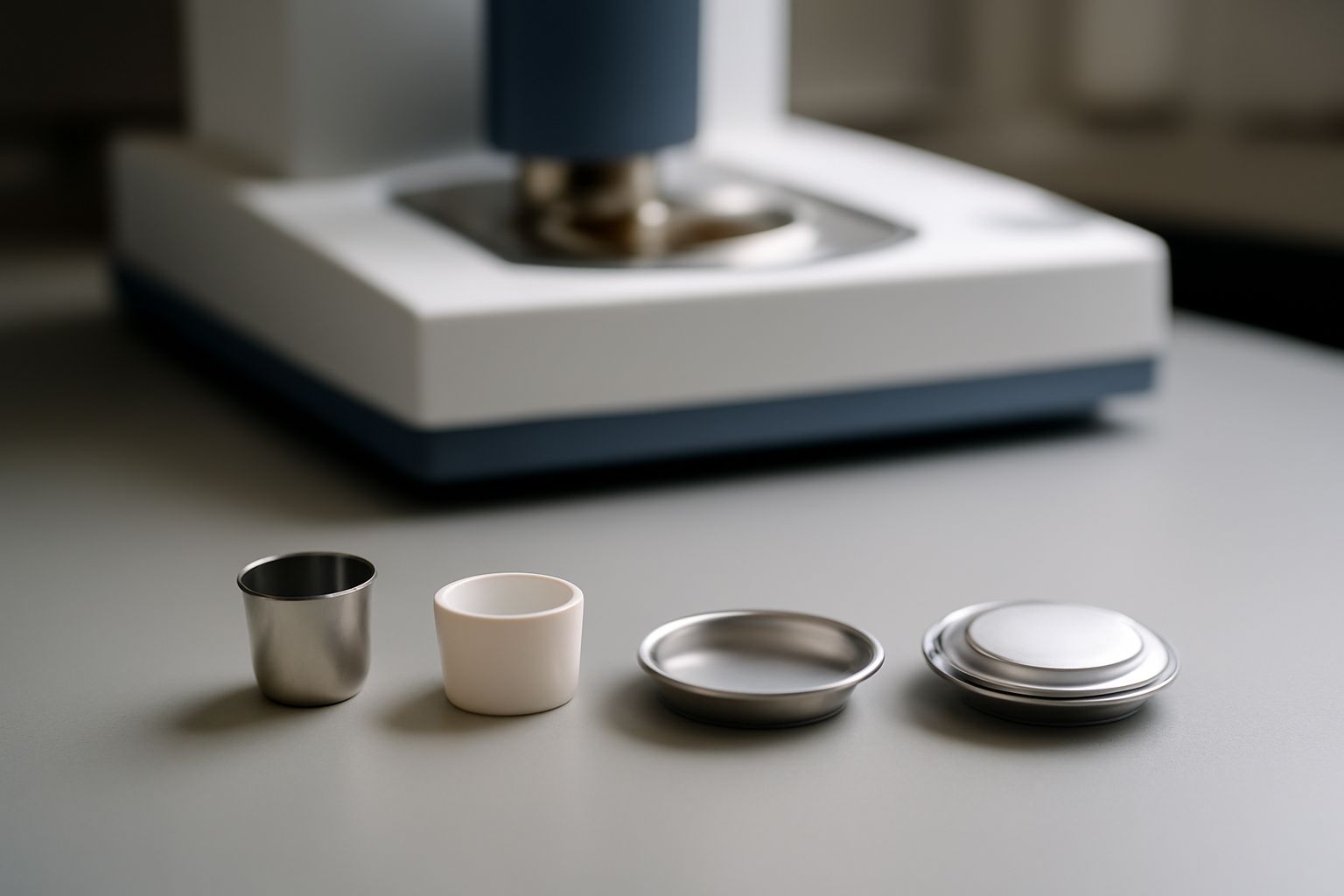Your cart is empty.
shop now
Your cart is empty.
shop now
If you pick the wrong sample container, you risk failing your thermal analysis and wasting your budget. The right choice means consistent results every time.
To choose the best thermal analysis sample container, match your selection to your application: use platinum or alumina for high temperatures, opt for sealed designs to protect atmosphere-sensitive samples, and consider your testing volume and custom needs.

There are many sample containers out there. Each type has a unique function. I have used them in settings ranging from research labs to large plants. Choosing what fits your job matters. If you look for the right material and design, you will save time and make good use of your resources. Let me walk through the main scenarios and help you find the best fit for your application.
You can get poor or even dangerous results if your pan fails at high heat. It costs you extra time and effort to repeat those tests.
The best sample containers for high-temperature applications are made from platinum or alumina. These materials resist both heat and chemical attack, offering maximum stability for demanding analyses.
I have seen many research teams switch to higher-grade pans only after failures at high temperature. Standard aluminum sample pans work well for basic DSC or TGA work, but not when temperature exceeds 600°C. Platinum and alumina sample pans are non-reactive, even during long cycles above 1000°C. The table below shows how the main sample pan materials compare for high-temperature performance. The need for purity and stable atmosphere becomes clear, especially in chemical and materials science labs.
| Container Material | Max Temp (°C) | Chemical Resistance | Applications |
|---|---|---|---|
| Aluminum | ~600 | Low | General DSC, TGA (organic samples) |
| Alumina | 1600 | High | Ceramics, metals, inorganics |
| Platinum | 1650+ | Very High | High-temp thermal analysis, extreme chemical samples |
Open containers can ruin results by letting air in. Many samples will react or lose mass the moment they touch oxygen or moisture.
For atmosphere-sensitive samples, sealed or hermetically closed pans prevent gas or moisture from reaching the sample. This ensures results reflect only the intended experiment, not contamination.
I learned the importance of sealing the hard way. Early in my career, I struggled with samples that showed odd mass loss. The culprit was always exposure to air during thermal ramps. Today, I recommend sealed crucibles or pans with O-rings for volatile or air-sensitive tests such as in pharmaceutical or polymer labs. Here’s a comparison of available sealing methods and their advantages for sensitive analyses:
| Sealing Type | Protection Level | Reusable? | Common Uses |
|---|---|---|---|
| Flat Lid (Non-sealed) | Minimal | Yes | Bland powders, non-volatile samples |
| Crimp-Sealed | Medium | No | Moisture/protein studies, organics |
| O-ring (High-Pressure Seal) | High | Variable | Volatile, atmosphere-sensitive or hazardous samples |
| Hermetic Pan | Highest | No | Gas evolution, micro-contamination studies |
More about sealed containers: Mettler Toledo Sealed Pans
If your lab runs a lot of thermal analysis, you can run out of pans fast or spend too much. Bulk testing brings its own set of challenges.
The most effective containers for high-volume testing are reliable, low-cost pans compatible with your instrument. Easy handling and quick sealing reduce downtime in busy labs.
In high-throughput environments, every minute counts. Many clients switch to REDTHERMO sample pans because we support instrument compatibility and fast delivery. Most high-volume labs use standard aluminum pans, which keep the cost per test low and enable automated loading and disposal. The easy fit with instruments like TA Instruments, NETZSCH, or PERKINELMER avoids the pain of test interruptions. The table below summarizes what to consider for high-volume pan selection:
| Factor | Why It Matters | Lab Impact |
|---|---|---|
| Compatiblity | No errors during loading, fit for autosamplers | Reduces failed runs |
| Cost/Pack | Keeps budget on track for hundreds/thousands of tests | Enables frequent replacements |
| Sealing/Ease of Use | Minimizes handling time, repeat testing | Improves lab productivity |
| Stock/Delivery | Quick restock to avoid stoppages | Keeps analysis on schedule |
Quick reference: Thermal Analysis Consumables for High-Throughput Labs
Some applications have unique needs. Off-the-shelf pans cannot always cover every size or sample property.
Custom sample containers, made to your exact drawings or samples, ensure accuracy and reliability where standard containers fall short. They offer the best fit for non-typical dimensions or special materials.
I have worked with clients needing pans for special shapes, new alloys, or unique research samples. Customized containers are vital for non-standard differential thermal analysis or for handling reactive chemicals that standard materials cannot tolerate. Quick communication about technical drawings or prototypes speeds up the process. Here’s how to weigh up the value of custom containers:
| Custom Feature | When Required | Benefit | Notes |
|---|---|---|---|
| Non-standard size/shape | When sample doesn't fit standard pans | Accurate measurement, better results | Precision engineering ensures repeatability |
| Special materials | Sample is reactive or melts at extreme temps | Prevents contamination, extends instrument life | Discuss with supplier about exact needs |
| Batch labeling or marking | When traceability is required | Tracks sample history, prevents confusion | Common in pharma and materials R&D |
| Functional modifications | Special vent holes or pressure rating | Enables specific test types | Custom designs increase safety and accuracy |
Recommended read: Design of Sample Holders – Thermo-analytical Applications
The right sample container improves every stage of thermal analysis. Choose by temperature, atmosphere, volume, or custom shape to boost results and save resources.
Contact REDTHERMO for expert help